

Home of K-fab
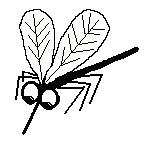
 |
|
 |
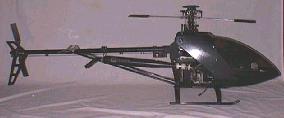 Well, it's time to pull out the old R/C Helicopters and start playing again. I've been flying for close to 15 years, but it's like my guitar playing - you'd have no idea I've been doing it that long. I SHOULD be a lot better than I am.
Well, it's time to pull out the old R/C Helicopters and start playing again. I've been flying for close to 15 years, but it's like my guitar playing - you'd have no idea I've been doing it that long. I SHOULD be a lot better than I am.
This page is a bit sporadic. I'm not exactly sure where I'll go, where I've been or what I'm doing here - which is pretty typical of me. I've just put down in words a summation of my modeling past, present and future. You will also discover the origins of my screen name 'Moskito' too.
Like just about every little boy, I was fascinated by model aircraft. I had plastic models of just about every WWII airplane and was always looking for a new one. As I grew, the idea of having them actually fly (besides throwing the plastic models off the roof) caught my thoughts. I started out building the old Gullow's rubber band powered balsa and tissue kits and advanced on from there. I designed my own gliders - some worked well, some worked like rocks. Still, it was a blast. I played with an old Cox .049 PT Trainer control line plane and a couple other Cox cl models too. If I had actually taken time to read the instructions on the first one, I would have discovered that the way you make them fly is to lean the needle out until the engine actually runs. You don't have to pull them through the air! Then, when I got into high school, I had a teacher that was a remote control (r/c) airplane enthusiast. I started going out to the flying field with him on the weekends, soaking up the idea of playing with one of these "real" toys, but being that I was the typical broke high school student, and that I rode a motocross bike most of my spare time, I didn't have the money to get involved with r/c toys. That would change as I got older.
When I went off to college, I finally took the plunge into the relm of r/c toys. My first r/c toy was a Tamiya off road buggy. It was the coolest kit I'd ever seen. Little oil filled shocks, metal suspension parts, real rubber tires and the likes. I spent hours driving it in the park across the street or chasing joggers, cars, bicycles - what ever wandered past my apartment - with it. No doubt about it, I was hooked. I still have the two channel Futaba radio that I got with the car.
After moving to San Antonio from South Texas in 1985, I started getting the flying itch. My room mate, Roel, also wanted to learn how to fly r/c planes, so we purchased a couple of Tower Hobbies ARF (almost ready to fly) ultralite models and began our adventures into the air. These ultralites were basically a 48" wide styrofoam wing with a bunch of small aluminum tubing hanging off of it to form the fuselage, landing gear and engine mount. They used three channels of a four channel radio and .15 size engine. Cheap price, cheap to build (and repair) and cheap design. Slow, forgiving and supposedly easy to fly. Sounded like the ideal trainer.To fly, Roel and I would have to load up the planes (I use this word loosely), the radios and all the gear to run them. We'd have to drive over to a stadium, hope that the parking lot was empty, and attempt to fly. This process usually took at least thirty minutes.
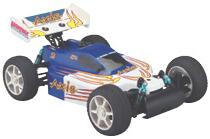 Now, keep in mind that neither of us had a clue as to what we were doing. We both had a lot of experience with r/c engines, as we'd been playing with 1:8 scale gas powered off road cars (gee, does that surprise you?) for a couple of years, but airplanes? They go up - yea, that's it - and if you're lucky, they come down and land in one controlled piece. So, for the first few days, we'd take turns just doing parking lot maneuvers. They went something like this:
Now, keep in mind that neither of us had a clue as to what we were doing. We both had a lot of experience with r/c engines, as we'd been playing with 1:8 scale gas powered off road cars (gee, does that surprise you?) for a couple of years, but airplanes? They go up - yea, that's it - and if you're lucky, they come down and land in one controlled piece. So, for the first few days, we'd take turns just doing parking lot maneuvers. They went something like this:
Get the plane pointed into the wind and not a fence (experience speaking)
Push the throttle up, watch the plane scoot along the asphalt
Add a little more throttle, get a little more speed
CAREFULLY pull back on the elevator stick, watch the plane come off the ground
PANIC
Pull back on the throttle, land - well, let it fall back down
Slow down enough to turn around and taxi it back to us. Give the pilot of the moment a pat on the back for a "successful flight" and then switch places, giving the guy that just flew a moment to gather himself back up for the next flight.
As our flights became actual controlled "touch and go's", the urge to get them higher stepped in. Roel was very deliberate and determined in his actions. He was the first to get the plane higher than 20 feet and actually initiate a turn, fly around in a large loop and set the plane back down. I was amazed with him doing it. That was cool! I, on the other hand, wasn't as patient or stable as he was. I finally got to the point of trying to do a turn and I didn't realize that after you initiate the turn, you let go of the rudder stick. (He COULD HAVE TOLD ME THAT!) Throttle up, speed up, plane leaves the ground, a little more altitude - up to about 50 feet, push on the rudder stick, plane begins to bank, hold stick in position, plane just banks right on over and starts into a nice dive. BOOM! Crash #1. I had successfully(?) augured my little foam and aluminum tubing plane into the parking lot.
Over the next couple of weeks, Roel and I repeated this flying/crashing scenario until the little planes could not be repaired any more. Time to move up to a newer, better "trainer"! We'd look through the 'Tower Hobbies' catalogs and dream about some of the really fancy kits with working ailerons, flaps, retracts - all the neat stuff. We finally settled on a couple of Box Fly 40's. These were a very gentle flying trainer. The engine for one of the Box Flys cost more than one of the entire ultralites we had been playing with.
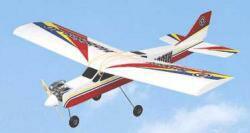 After a some successful flights and some not so successful flights, the "day of reckoning" came and I managed to loose control of my Box Fly 40 and stick it into the ground so hard that I broke the engine case. Wasn't too long that Roel managed to have a nasty that totaled his too. The thought of playing in the sky was beginning to get very frustrating. Too much work to load up, travel, unload, crash, load, come home, blah, blah, blah.
After a some successful flights and some not so successful flights, the "day of reckoning" came and I managed to loose control of my Box Fly 40 and stick it into the ground so hard that I broke the engine case. Wasn't too long that Roel managed to have a nasty that totaled his too. The thought of playing in the sky was beginning to get very frustrating. Too much work to load up, travel, unload, crash, load, come home, blah, blah, blah.
I don't remember which one of us saw it first. We'd gone into the local hobby shop - Rebel Radio - and there it was. A GMP Cobra Helicopter. This was the most impressive, intricate, beautiful r/c model I'd ever seen. We both decided right there - we were gonna go to helicopters instead of planes. It just made sense. No more traveling to fly. We lived on a cul-de-sac, so all we had to do was go out the front door and drop them in the street. Another great thing was that you didn't need very much room to learn to fly. You have to start hovering and we had more than enough room for that. So, blind as bats, (or so the saying goes) we dove into the realm of rotary winged aircraft.
Each of us with new helicopter kits, new six channel radios, new engines and these odd little things called a gyro tucked under our arms, we headed home and began building our new toys. Now, I was used to wood, glue, paper and stuff. Not a thing like this was in my kit. Bolts, screws, aluminum and plastic pieces abound. It was like building a big complicated erector set. Over the next few days we built our new toys and got them ready for the dreaded first flights.
One thing that we had been told - and actually listened to - was that we would want 'training gear' on our birds. This was nothing more than a hula hoop attached to the landing gear of the heli with some small dowel rod. The idea was that the landing gear covered an area of about a square foot. The rotors were about five feet in diameter - a lot bigger than the landing gear. Tipping over was very easy. So, by putting the training gear on the ability of the heli to tip over was drastically reduced. This was a GOOD thing!
Fire up the heli. Set it out in the middle of the cul-de-sac, step back and watch the rotors begin to spin. Add a little bit of throttle, and suddenly the tail starts to spin around! WHAT THE??? Ah, add in a little rudder and look, it holds it's position. I don't remember how long we chased the tail and worked on getting the feeling for what would happen. Then, I got brave and started adding a little more throttle. Suddenly, the helicopter has enough throttle and lift and begins to get light on the skids. It begins to DRIFT, following the curve of the street! THROTTLE DOWN!!! After a couple more tanks of fuel I began to get the feeling of what the heli would do and was able to scoot it all over the street. I was on my way.
The first time the bird actually left the ground - about 3" - it scared the crap out of me! It was suddenly hovering! I froze, panicked and slammed it back down on the ground. I'd hovered! - well, in my mind it was a hover - it did leave the ground and come back in one piece. This was done over and over and soon I was actually hovering about a foot off the ground. Roel was right on track too. We were FLYING!"
As our days progressed, we began to hover around the cul-de-sac, over the yards, over the sidewalks - what ever. Never getting more than eight to ten feet off the ground. We'd discovered that controlling these things was pretty tricky. It was a given that the take off pad was the man hole cover in the middle of the street. This also became the landing pad too. Hitting this thing was not easy. You could get close and then you'd begin to over compensate and wander all around it. More fuel, more flights and soon, we were landing on the cover pretty confidently. Still no mishaps either.
The neighborhood we lived all had large brick mail boxes. Each one was a landing tower. One afternoon, I decided that I was competent (good?) enough to try landing on one of the flat topped mail boxes. Hover up, move closer, slowly hover down. I'd done it! There sat my blue and red Cobra on top of the neighbor's mail box. I was King! Soon, Roel was doing the same.
Then came the fateful day
I approached my favorite landing pad mail box - skids about a foot above the top - moved in towards it and just as the nose got over the top of the mail box, a gust of wind came by and pushed my heli down. The blades hit the box and it was over. BOOM!!! Parts scattered, pieces flew, I was crushed.
 Over the next year and a half, I'd go thru three different kits (GMP Cobra, Hirobo Shuttle, original wood tray X-Cell 60) fly a lot of fuel and begin to get pretty descent with forward flight. Then I got married and quit flying. It was almost four years that I went without playing with my r/c heli.
Over the next year and a half, I'd go thru three different kits (GMP Cobra, Hirobo Shuttle, original wood tray X-Cell 60) fly a lot of fuel and begin to get pretty descent with forward flight. Then I got married and quit flying. It was almost four years that I went without playing with my r/c heli.
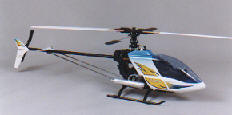 I had the X-Cell hanging in my shop for years. One afternoon, I looked up and thought - gee, I haven't done that in a LONG time! I pulled it down, went thru it and began to fly again. What a blast. One really cool thing was that down the road from me - about a mile or so - was a man by the name of Slim. It just happens that Slim was into helis also. Really into them. He sold them, flew them made parts for them, lived, ate and breathed them. I started going down to his place with my X-Cell and flying more and more.
I had the X-Cell hanging in my shop for years. One afternoon, I looked up and thought - gee, I haven't done that in a LONG time! I pulled it down, went thru it and began to fly again. What a blast. One really cool thing was that down the road from me - about a mile or so - was a man by the name of Slim. It just happens that Slim was into helis also. Really into them. He sold them, flew them made parts for them, lived, ate and breathed them. I started going down to his place with my X-Cell and flying more and more.
Even though I was flying more, I was still very definitely a beginner. I would hover around (always tail in), fly out away from myself and then hover back (tail still in). Getting the heli even remotely sideways or Heaven forbid, nose in, was not an option. Slim finally walks up behind me one day and says "Do a pierouette". (spin the helicopter around the axis of the main shaft)
"WHAT?!?"
"Do a pierouette!"
"NO WAY! I can't do that!" He kept riding me. Finally, I put in a bunch of rudder and there it was - a pierouette. Well, that wasn't TOO bad. I sat the heli down with my sweating, shaking hands. I was beginning to enter the actual "flying" phase.
I practiced more pierouettes and even learned how to stop them with the heli not tail in. I was able to recover from sideways positions and began to fly back and forth in front of me. This was fun.
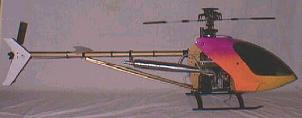 Now, being that Slim is a Robbe/Schluter dealer, and I was flying a Miniature Aircraft X-Cell, he was always riding me about having an inferior helicopter. "You gotta sell that thing and get a REAL helicopter." Robbe had just released a new 60 size bird called a Futura. This thing was big, beefy and very well laid out. On and on Slim rode me - "You need one of these" he'd tell me. Finally, one afternoon, just before my first daughter was born, I tried flying his Futura. Never had I flown such a stable, solid machine! I wanted one! Three days after my daughter was born, I had my new Futura. Beautifully gold anodized aluminum frame and tail boom, one piece canopy, exquisite German engineering.
Now, being that Slim is a Robbe/Schluter dealer, and I was flying a Miniature Aircraft X-Cell, he was always riding me about having an inferior helicopter. "You gotta sell that thing and get a REAL helicopter." Robbe had just released a new 60 size bird called a Futura. This thing was big, beefy and very well laid out. On and on Slim rode me - "You need one of these" he'd tell me. Finally, one afternoon, just before my first daughter was born, I tried flying his Futura. Never had I flown such a stable, solid machine! I wanted one! Three days after my daughter was born, I had my new Futura. Beautifully gold anodized aluminum frame and tail boom, one piece canopy, exquisite German engineering.
I really cut my teeth flying the Futura. With it I learned to hover nose in, do loops, do auto rotations (where you cut the throttle and just "glide" in and in general got the basics of flying down. I went from chasing the heli and reacting to what it did to flying the heli and making it do what I want.
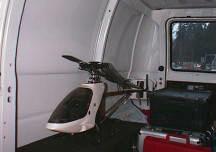 Almost seven years later, I'm still flying flying the old gold Futura. It's been given the nick name "Ol' Reliable". It's seen a lot of flights, three engines, many crashes - including two complete rebuilds (never did find the tail rotor from the roll attempt) and it's even been flown inside the Seattle King Dome! It traveled all over the country with me last year ('99 ) during my Stadium Racing tour and provided a lot of fun and relaxation. Each time it goes into the ground, I update what ever's been destroyed with the latest parts off of the Futura SE - the upgraded 3-D competition version of the Futura. It's about 85% SE now, but retains the old gold anodized aluminum scheme and is still my most solid flyer.
Almost seven years later, I'm still flying flying the old gold Futura. It's been given the nick name "Ol' Reliable". It's seen a lot of flights, three engines, many crashes - including two complete rebuilds (never did find the tail rotor from the roll attempt) and it's even been flown inside the Seattle King Dome! It traveled all over the country with me last year ('99 ) during my Stadium Racing tour and provided a lot of fun and relaxation. Each time it goes into the ground, I update what ever's been destroyed with the latest parts off of the Futura SE - the upgraded 3-D competition version of the Futura. It's about 85% SE now, but retains the old gold anodized aluminum scheme and is still my most solid flyer.
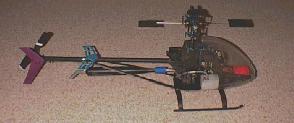 So, have you wondered where all this 'Moskito' stuff is from? Lemme tell ya about it. (:
So, have you wondered where all this 'Moskito' stuff is from? Lemme tell ya about it. (:
Back when I first got on the internet, via AOL, I was sitting in the basement going through the sign up process. One of the first things AOL wanted was a screen name. Naturally at this point in time my mind goes totally blank. I can't think of a thing. I start looking around the immediate area - uh, 'screen', nope, uh, 'keyboard' - boy that's stupid. Like I said, totally blank. Next I broaden my scope and start looking around the room. I see my helicopters sitting in formation on the table. Ah, my Robbe/Schluter Moskito! And, thus the model's name and German spelling was taken for my screen name. To quote Paul Harvey, "And now, you know the rest of the story!"
My wife pulled a fast one on me with the Moskito. She'd been with me when I'd stopped by Slim's place a couple times. Slim, being the ever ready opportunist, pulls her aside - "I have something you need to get Richard for Christmas" and he pulls out a kit of the new (at the time) Moskito. This was the cutest little heli going. It was a 40 size heli with a three wheel landing gear setup and a molded canopy complete with pilot figure.
I'd flown Slim's Moskito and thought it was a blast, but getting another heli within five months of getting a new Futura was the last thing on my mind. I was thinking about the BK-117 fuselage that Slim had in his shop for my now mothballed X-Cell 60. I'd been wheeling and dealing with Slim on the BK fuselage for a couple months and one morning I head over to his place - planning on taking the kit back to my wife and saying "LOOKIE HERE - hint, hint" hoping that she'd take the bait and get it for me for Christmas. I get to Slim's and he tells me that the BK fuselage is GONE! I was bummed! Oh well, I still had a new Futura and was flying the thing at least a couple times a week. Heck we were even flying out in the middle of winter in the snow!
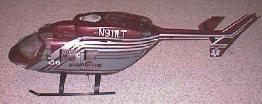 Under the Christmas tree was a pair of fairly large boxes with my name on them. I was at a total loss. I picked up one of them, shook it and said "If I didn't know better, I'd think this was a heli kit". My wife kept a poker face and said I needed another heli like I needed a hole in the head. I couldn't argue. I had a new Futura and an X-Cell as a spare. I still wanted a BK fuselage for the X-Cell. Christmas day came and I opened the first box - the one I'd shaken. Don't you know, Slim and my wife had pulled the wool over my eyes and there I was holding a brand new Moskito kit!
Under the Christmas tree was a pair of fairly large boxes with my name on them. I was at a total loss. I picked up one of them, shook it and said "If I didn't know better, I'd think this was a heli kit". My wife kept a poker face and said I needed another heli like I needed a hole in the head. I couldn't argue. I had a new Futura and an X-Cell as a spare. I still wanted a BK fuselage for the X-Cell. Christmas day came and I opened the first box - the one I'd shaken. Don't you know, Slim and my wife had pulled the wool over my eyes and there I was holding a brand new Moskito kit! 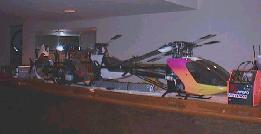 Next, I moved on to the other big box. Hmmm, it's light, doesn't seem to shake much. I pull off the paper and there's the BK-117 fuselage that had been sold a couple months back! I was totally blown away. Life was treating me great!
Next, I moved on to the other big box. Hmmm, it's light, doesn't seem to shake much. I pull off the paper and there's the BK-117 fuselage that had been sold a couple months back! I was totally blown away. Life was treating me great!
I had the Moskito flying in a couple days. I had to track down an engine & muffler, servos, gyro and radio receiver (my JR PCM10SX will store 10 models, so I didn't need another radio). It was so quick and agile compared to the Futura - almost hyper. What a blast. The BK fuselage, on the other hand took about six months of slow paced work, but the results were worth the time and effort - especially since it was my first attempt at a scale model.
A buddy of mine describes my approach to things as "Step over the line, loose a toe and then pull back." - meaning that I have a bad habit of pushing the envelope past my abilities and then working backwards to my actual level. When I was flying two and three times a week, I was really pushing myself. Loops and such were getting bigger and better - so were the crashes and the bills. I got to a point where I would go to Slims with two working birds and come home with parts. It began to get old and I had also started back into my motocross stuff. I began to get burnt out on flying and ended up putting the helis on the shelf for a couple years. Kind of a shame.
Recently, I've got the bug again. I put both my Futuras back together and got them both in flying condition (The Moskito's ready too) and have started playing with them on a more regular basis. Boy, talk about rusty! My first loop ended with me pulling off a fairly nice round one and then setting down the bird with shakey hands. Adrenaline rushes are hard to work with. Smooth and steady is the must. Time for more practice!
Four Stroke Futura Project
How To Upgrade a Gold Futura to a Gold SE